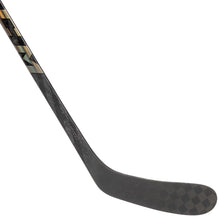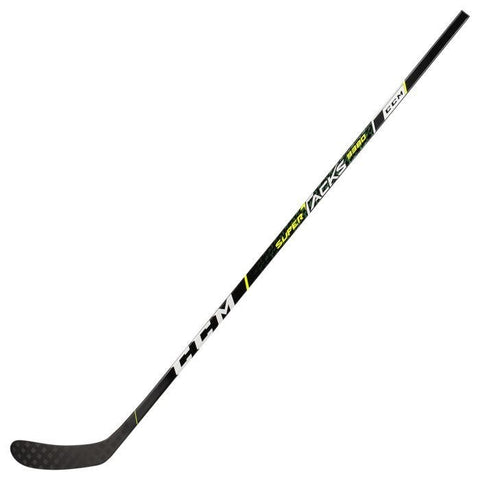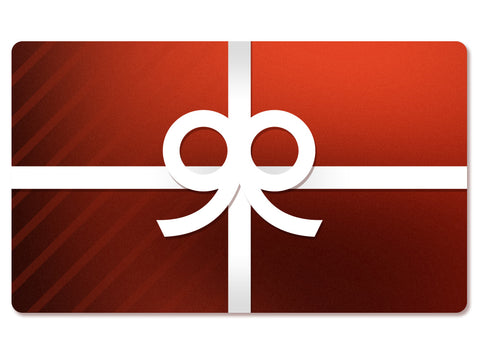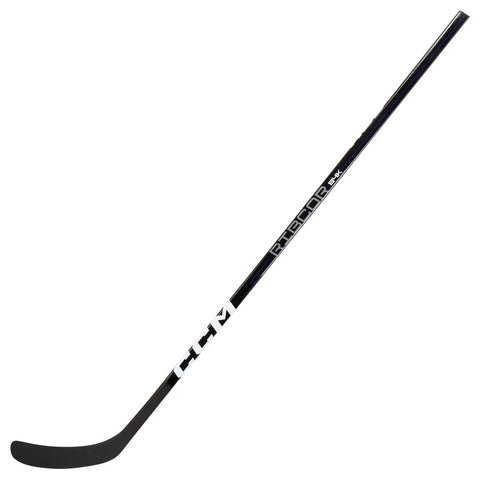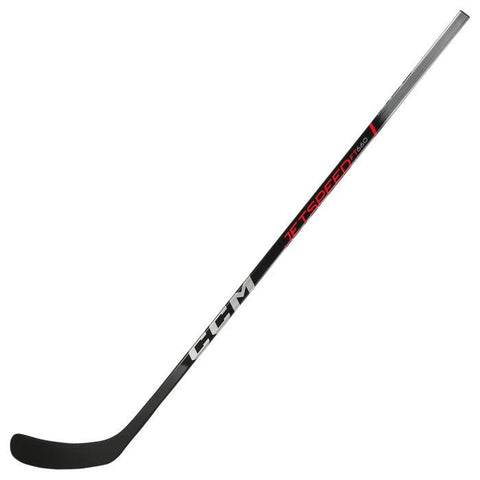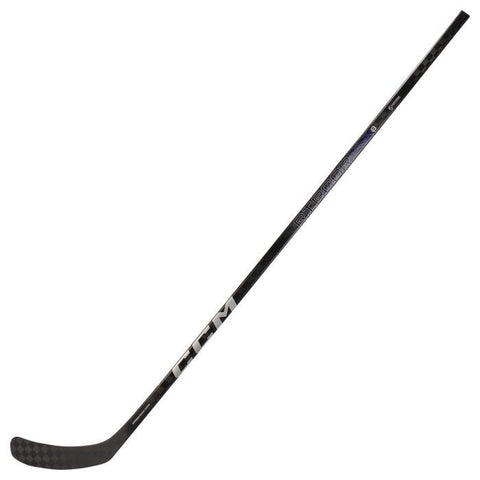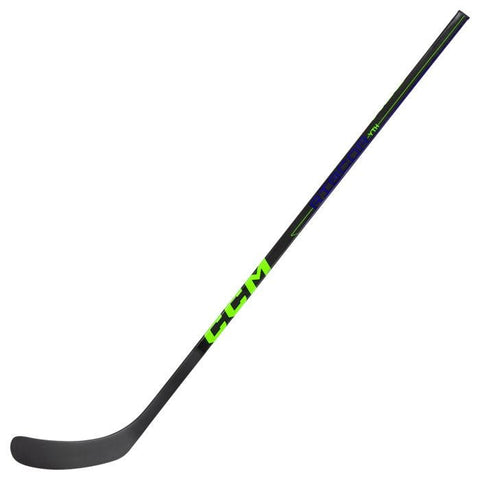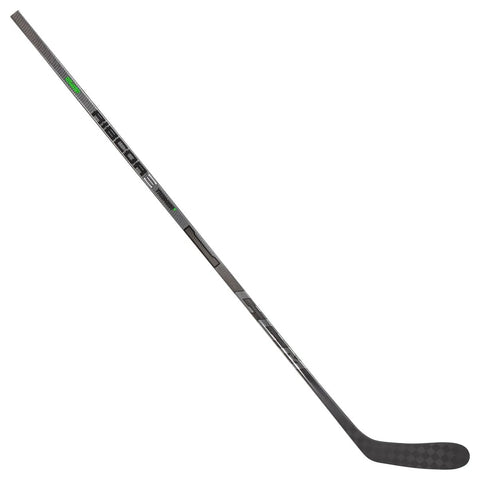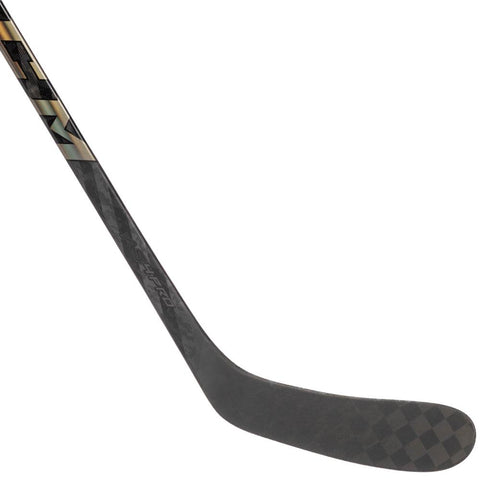It’s important to know how to find the right size hockey stick—as your tool on the ice, your stick needs to fit well or it will affect your shooting, passing, and blocking ability. Our guide on hockey stick sizing will show you how to find the right size stick for your build and your game.
In addition to proper length, a good fitting hockey stick has the right flex, kick point, blade features, and grip for your position and playing style.
WHAT SIZE HOCKEY STICK DO I NEED?
How long your hockey stick should be typically depends on your height, although personal preference can also play a role. Hockey stick length is usually the easiest variable to determine when picking the right stick for you.
MEASURING HOCKEY STICK LENGTH
Have the player stand without skates. Then, place the toe of the stick on the ground between the player's feet, positioning the stick vertically. The general rule is that the end of a proper length stick should come to about the nose. However, if the player's skates are on, the stick should come up to the chin. This measurement is just a starting point and not an exact science, so your player may want a shorter or longer stick depending on their playing style, position or personal preference.
Sticks come in four sizes: Senior, Intermediate, Junior, and Youth. Each descending size is shorter and normally offers a smaller shaft circumference and a lower flex. Senior sticks are usually used by players ages 14 to adult; Intermediate sticks by players ages 10-15 and by some adult female players; Junior sticks by ages 7-12; and Youth sticks by players ages 4-8.
HOCKEY STICK FLEX
The first thing many players do when fitting a new hockey stick is bend it. Why? Because they are testing out the "flex" or flexibility of the stick. A good hockey stick fit allows the player to bend the shaft a little without much effort. Most players prefer flexible and lightweight shafts that allow for optimal passing and shooting. A too-stiff stick shaft decreases shot accuracy and puck speed, and it does not provide a good feel for the puck.
Most stick manufacturers offer a variety of flex ratings. The higher the flex number, the stiffer the stick. The correct flex should allow players to bend the shaft when they take a wrist shot or slap shot. For more detailed information on determining flex, visit our Hockey Stick Flex Guide.
HOCKEY STICK KICK POINT
The kick point is the area where the hockey stick flexes when you pass and shoot. It’s another important variable to consider when evaluating a hockey stick. Mid- to high kick points help with the load and release of energy, great for slap shots and powerful passes, while low kick points help with quicker puck release, ideal for wrist shots and more agile puck handling.
With CCM, the Ribcor stick’s low kick point and stiff blade maximize release speed for blistering shots from close to the net. The high kick point and extra stiff blade on a Tacks stick means booming shots that are all about power. And the mid to low hybrid kick point in the JetSpeed stick maximizes versatility: aim with precision and power from various positions on the ice. CCM stick material options include a high-tech carbon fiber weave that offers stiffness and strength, or a new material called Sigmatex—developed specifically for CCM by aerospace leaders—that combines strength and resilience with even lighter weight for more responsive handling.
GRIP VS. NON-GRIP HOCKEY STICKS
Hockey sticks mainly come with a textured, sticky surface (grip). The non-grip sticks are only available for custom stick orders.
You can make your hockey stick grip better by fashioning a grip yourself from hockey tape. The main purpose of grip is to provide increased control and prevent your hands from sliding unintentionally on the stick if the player's gloves are wet.
Customizing the grip at the butt end of the stick is also an option. Whether or not you’ve altered the length of the stick shaft, Some players like a smooth grip, which allows easy top-hand movement, while others prefer a raised grip, which keeps the stick from twisting. A spiral-rib grip may be easier for you to hold onto, and you can easily make your own with standard hockey tape.
HOW TO CHOOSE A HOCKEY STICK BLADE PATTERN
A different hockey stick blade curve—also called its pattern—is used for different skill sets, and it’s one of the easiest stick fit variables to see. Please view our blade pattern guide for different specs and pattern names for different curves from various manufacturers. Stick pattern is almost entirely a matter of player preference, with the location of the curve in the blade moving toward the toe for players who favor wrist shots and handling the puck. Defensive players and those who favor big slap shots tend to prefer the blade curve toward the heel.
HOCKEY STICK BLADE CURVES
The hockey stick blade's curve location or type has an enormous influence on shooting the puck. Think of it this way: the puck will pretty much always find its way to the most curved section of the blade. So, when you start to take a shot, the puck will be in that section. However, the puck then needs to make it to the very end of the blade. The closer to the heel that 'starting' point is, the longer it will take to get to the end, resulting in a longer release and more time to build up power and velocity.
Let’s talk about the differences in heel curve, mid curve, and toe curve blade patterns. You’ll need the right blade curve pattern for your hockey stick to fit your style of play.
Heel Curve Blade Pattern:
- The majority of the blade curve is in the first 1/3 of the blade from the shaft
- Perfect for high-velocity shots
- Often popular among defensemen
Mid Curve Blade Pattern:
- The majority of the curve is in the middle of the blade
- Great all-around performance on various types of shots
Toe Curve Blade Pattern:
- The majority of the curve is in the end 1/3 of the blade
- Great for quick-release shots
- Can help with puck handling and control
- Often popular with forwards who like to shoot in stride
OPEN FACE VS. CLOSED FACE HOCKEY BLADES
With ‘open face’ hockey blades, the open face allows you to get the puck higher, quicker because the puck rolls off the blade, similar to a golf club. This feature is beneficial to players who take a lot of shots from in tight and want to go upstairs. An open face blade is also great for players who make their living in front of the net, banging home rebounds—they don’t have much space to get the puck over the goalie and through traffic, and open curves don't require as much of a follow through when shooting high, allowing players to get it off without much space.
Some open-faced blade patterns also help to disguise the shooter's target to the goalie. This stick looks similar no matter where the shot is going. The shooter doesn't need to open the blade as much when shooting high, something good goalies are trained to look for. An open curve makes it easier to get saucer passes in the air. It can also help players receive passes on their backhands, great for players who often play their ‘off-wing.'
A closed face curve pattern allows for more accurate shooting in general as the puck stays more square to the blade through the shooting motion. Closed curves require more of a full follow-through and more of a giveaway to the goalie to get the puck high, but they're often more accurate. Closed curves are also better for puck control.
ROUND TOE VS. SQUARE TOE HOCKEY BLADE








